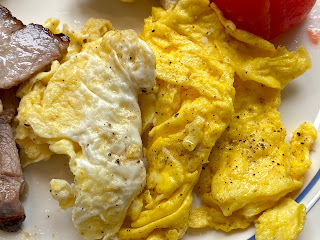When we order broccoli using our grocery home delivery service, we usually get three giant heads (see picture below). It is not possible to consume everything before it spoils so I separate it into florets, steam them and freeze them in Ziploc bags in small batches for future use.
Recently we saw
an interesting recipe on YouTube which uses a large amount of broccoli. Although the original recipe uses fresh broccoli, we figured blanched and frozen broccoli should work. As usual, we made substantial changes mostly due to the ingredients available. We really like the idea of making broccoli cups. We could come up with different kinds of stuffings. In any case, this was our first try. The stuffing was a bit crumbly.
The broccoli cups retained their shape well.
Ingredients: (made 9)
For the broccoli cup4 cup finely chopped broccoli (we used blanched and frozen, separated each frozen florets and chopped up in a small batches using the food processor fitted with cutting blade. If using fresh broccoli, the original recipe grated the broccoli using a box grater)
2-3 eggs (2 eggs may have been better, excess egg pooled on the bottom of the cup when baked but we did not use 2 chopped boiled eggs in the stuffing which was in the original recipe. So, it sort of worked out)
1/2 cup grated Parmesan cheese (optional)
For stuffing1 cup finely chopped onion
2 Jalapeño peppers, seeded and veined, finely chopped (or green pepper)
3 cloves of garlic, finely chopped
2 small carrots, peeled and cut into small dice
1/2 cup fresh shiitake mushroom stems, finely chopped (optional, since we had this. First tear length wise and then chop)
1-2 tbs olive oil
1 package feta cheese, crumbled
1/2 cup each grated smoked Gouda and Cheddar cheese
For the sauce (a type of aurora sauce)
Greek yogurt and Mayonnaise equal amount
Ketchup
Parsley and chives, chopped
Directions:For broccoli cupsMix the broccoli, eggs, and Parmesan cheese
Divide the broccoli mixture in 12 equal portions and place in a muffin tin lined with paper muffin cups (#1)
Using fingers or spoon, spread the mixture to make a cup (#2)
Bake at 350F for 15 minutes (#3, note the egg pooled on the bottom and cooked)
For stuffingSauté the stuffing ingredients except for cheeses in the olive oil for 2-3 minutes and turned down the heat with the lid one for 7 more minutes. Season with salt and pepper
Let it cool down a bit and mixed in the feta cheese
Final assemblyPlace the stuffing in the baked broccoli cups (#4)
Top each with the grated cheeses (#5)
Bake 15-20 minutes at 350F (#6)
This is a surprisingly good dish. Next day, we reheated this in the toaster oven and had it as a lunch. Compared to freshly baked, the broccoli flavor it less intense and tasted better. stuffing tended to crumble but tasted great especially the umami the shiitake imparted. We can play with the stuffings to our liking. This is a great recipe to use a large amount of broccoli.



















































